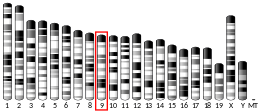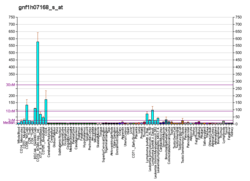RP9
Retinitis pigmentosa 9 (autosomal dominant), also known as RP9 or PAP-1, is a protein which in humans is encoded by the RP9 gene.[5]
| RP9 | |||||||||||||||||||||||||
|---|---|---|---|---|---|---|---|---|---|---|---|---|---|---|---|---|---|---|---|---|---|---|---|---|---|
| Identifiers | |||||||||||||||||||||||||
| Aliases | RP9, PAP-1, PAP1, retinitis pigmentosa 9 (autosomal dominant), pre-mRNA splicing factor, RP9 pre-mRNA splicing factor | ||||||||||||||||||||||||
| External IDs | OMIM: 607331 MGI: 2157166 HomoloGene: 10290 GeneCards: RP9 | ||||||||||||||||||||||||
| |||||||||||||||||||||||||
| |||||||||||||||||||||||||
| |||||||||||||||||||||||||
| |||||||||||||||||||||||||
| Orthologs | |||||||||||||||||||||||||
| Species | Human | Mouse | |||||||||||||||||||||||
| Entrez | |||||||||||||||||||||||||
| Ensembl | |||||||||||||||||||||||||
| UniProt | |||||||||||||||||||||||||
| RefSeq (mRNA) | |||||||||||||||||||||||||
| RefSeq (protein) | |||||||||||||||||||||||||
| Location (UCSC) | Chr 7: 33.09 – 33.11 Mb | Chr 9: 22.41 – 22.47 Mb | |||||||||||||||||||||||
| PubMed search | [3] | [4] | |||||||||||||||||||||||
| Wikidata | |||||||||||||||||||||||||
| |||||||||||||||||||||||||
Function
The removal of introns from nuclear pre-mRNAs occurs on a complex called a spliceosome, which is made up of 4 small nuclear ribonucleoprotein (snRNP) particles and an undefined number of transiently associated splicing factors. The exact role of PAP-1 in splicing is not fully understood, but it is thought that PAP-1 localizes in nuclear speckles containing the splicing factor SC35 and interacts directly with another splicing factor, U2AF35.[6]
Clinical significance
Mutations in PAP1 underlie autosomal dominant retinitis pigmentosa mapped to the RP9 gene locus.[7]
Interactions
RP9 has been shown to interact with U2 small nuclear RNA auxiliary factor 1.[6]
References
- GRCh38: Ensembl release 89: ENSG00000164610 - Ensembl, May 2017
- GRCm38: Ensembl release 89: ENSMUSG00000032239 - Ensembl, May 2017
- "Human PubMed Reference:". National Center for Biotechnology Information, U.S. National Library of Medicine.
- "Mouse PubMed Reference:". National Center for Biotechnology Information, U.S. National Library of Medicine.
- "Entrez Gene: RP9 retinitis pigmentosa 9 (autosomal dominant)".
- Maita H, Kitaura H, Keen TJ, Inglehearn CF, Ariga H, Iguchi-Ariga SM (November 2004). "PAP-1, the mutated gene underlying the RP9 form of dominant retinitis pigmentosa, is a splicing factor". Exp. Cell Res. 300 (2): 283–96. doi:10.1016/j.yexcr.2004.07.029. PMID 15474994.
- Keen TJ, Hims MM, McKie AB, Moore AT, Doran RM, Mackey DA, Mansfield DC, Mueller RF, Bhattacharya SS, Bird AC, Markham AF, Inglehearn CF (April 2002). "Mutations in a protein target of the Pim-1 kinase associated with the RP9 form of autosomal dominant retinitis pigmentosa". Eur. J. Hum. Genet. 10 (4): 245–9. doi:10.1038/sj.ejhg.5200797. PMID 12032732.
Further reading
- Inglehearn C, Keen TJ, al-Maghtheh M, Bhattacharya S (1994). "Loci for autosomal dominant retinitis pigmentosa and dominant cystoid macular dystrophy on chromosome 7p are not allelic". Am. J. Hum. Genet. 55 (3): 581–2. PMC 1918416. PMID 8079997.
- Inglehearn CF, Carter SA, Keen TJ, et al. (1993). "A new locus for autosomal dominant retinitis pigmentosa on chromosome 7p". Nat. Genet. 4 (1): 51–3. doi:10.1038/ng0593-51. PMID 8513323.
- Maita H, Harada Y, Nagakubo D, et al. (2000). "PAP-1, a novel target protein of phosphorylation by pim-1 kinase". Eur. J. Biochem. 267 (16): 5168–78. doi:10.1046/j.1432-1327.2000.01585.x. PMID 10931201.
- Keen TJ, Hims MM, McKie AB, et al. (2002). "Mutations in a protein target of the Pim-1 kinase associated with the RP9 form of autosomal dominant retinitis pigmentosa". Eur. J. Hum. Genet. 10 (4): 245–9. doi:10.1038/sj.ejhg.5200797. PMID 12032732.
- Strausberg RL, Feingold EA, Grouse LH, et al. (2003). "Generation and initial analysis of more than 15,000 full-length human and mouse cDNA sequences". Proc. Natl. Acad. Sci. U.S.A. 99 (26): 16899–903. doi:10.1073/pnas.242603899. PMC 139241. PMID 12477932.
- Scherer SW, Cheung J, MacDonald JR, et al. (2003). "Human chromosome 7: DNA sequence and biology". Science. 300 (5620): 767–72. doi:10.1126/science.1083423. PMC 2882961. PMID 12690205.
- Maita H, Kitaura H, Keen TJ, et al. (2004). "PAP-1, the mutated gene underlying the RP9 form of dominant retinitis pigmentosa, is a splicing factor". Exp. Cell Res. 300 (2): 283–96. doi:10.1016/j.yexcr.2004.07.029. PMID 15474994.
- Gerhard DS, Wagner L, Feingold EA, et al. (2004). "The status, quality, and expansion of the NIH full-length cDNA project: the Mammalian Gene Collection (MGC)". Genome Res. 14 (10B): 2121–7. doi:10.1101/gr.2596504. PMC 528928. PMID 15489334.
- Maita H, Kitaura H, Ariga H, Iguchi-Ariga SM (2005). "Association of PAP-1 and Prp3p, the products of causative genes of dominant retinitis pigmentosa, in the tri-snRNP complex". Exp. Cell Res. 302 (1): 61–8. doi:10.1016/j.yexcr.2004.08.022. PMID 15541726.
- Kuroda TS, Maita H, Tabata T, et al. (2004). "A novel nucleolar protein, PAPA-1, induces growth arrest as a result of cell cycle arrest at the G1 phase". Gene. 340 (1): 83–98. doi:10.1016/j.gene.2004.05.025. PMID 15556297.
- Maita H, Kitaura H, Ariga H, Iguchi-Ariga SM (2005). "CIR, a corepressor of CBF1, binds to PAP-1 and effects alternative splicing". Exp. Cell Res. 303 (2): 375–87. doi:10.1016/j.yexcr.2004.10.012. PMID 15652350.




